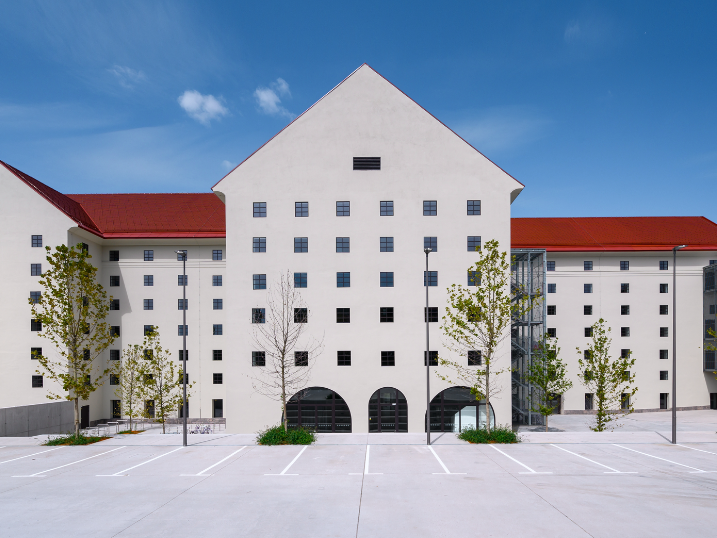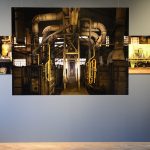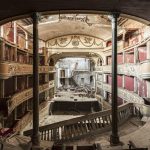english below
Cukrarna un nuovo spazio per l’arte contemporanea a Lubiana, Slovenia
Cukrarna, uno spazio recentemente rinnovato per la produzione e la presentazione dell’arte contemporanea, ha aperto le sue porte al pubblico. Uno degli esempi più monumentali di architettura industriale a Lubiana, fonte di ispirazione per un importante quartetto di modernisti, uno spazio espositivo moderno e anche un punto di riferimento urbano che ci invita a passeggiare lungo la Ljubljanica fino al confine orientale del centro città. La Città di Lubiana, che dal 2018 guida l’ampia ristrutturazione dell’edificio – su progetto dello studio di architettura Scapelab – ha affidato la gestione di Cukrarna al Museo e alle Gallerie di Lubiana. La mostra inaugurale, intitolata The Wonderfulness of Memory, si concentra sull’intreccio tra passato e presente.
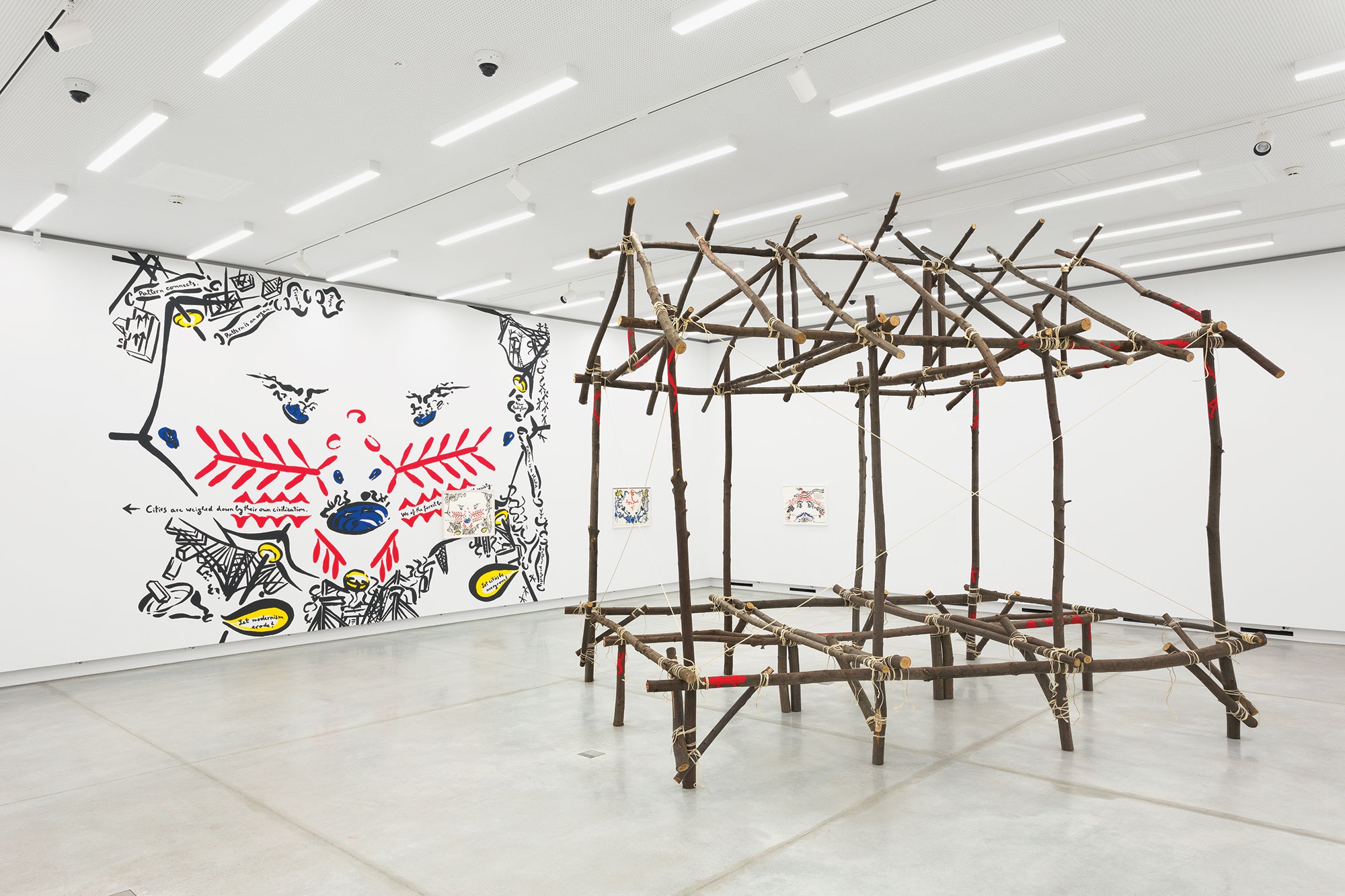
Marjetica Potrč, The House of Social Agreement, ph. Andrej Peunik
Il progetto architettonico di Scapelab
Il progetto di Marko Studen, Boris Matić e Jernej Šipoš dello studio di architettura Scapelab si è basato sulla storia della Cukrarna, sul nuovo contenuto, sull’orientamento futuro dell’edificio e sullo stato della struttura esistente.
L’analisi dello stato dei materiali prima dell’inizio della ristrutturazione ha mostrato che le pareti erano sul punto di crollare. Insieme alla città di Lubiana e all’Istituto per la protezione del patrimonio culturale, abbiamo salvato Cukrarna all’ultimo minuto. Se non lo avessimo fatto, avrebbe subito la stessa sorte del complesso Kolizej a Lubiana o dell’ex Mulino Rakusch a Celje.
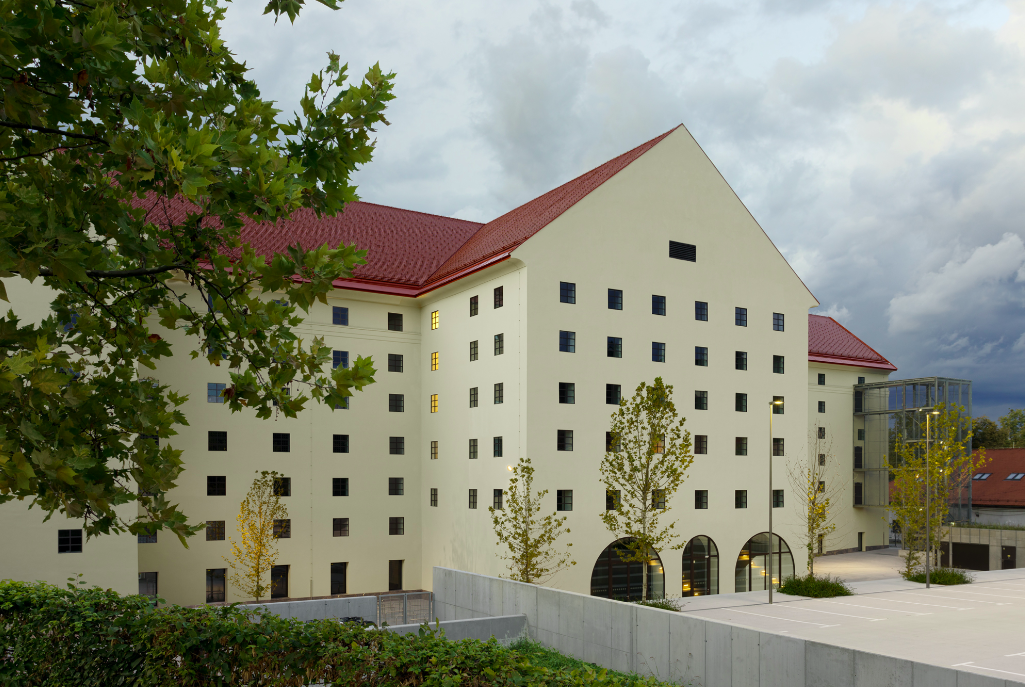
ph. Andrej Peunik
L’ingresso principale dell’edificio è dal lato del fiume. Il piazzale antistante l’ingresso collega la pista ciclo-pedonale che costeggia l’argine Poljanski Nasip. Il piano terra è l’unica parte dell’edificio illuminata da luce naturale; per entrambi i volumi della galleria è prevista la regolazione di luce, ventilazione, temperatura e umidità. I due cubi galleggianti sono rivestiti in lamiera forata, che assolve a una funzione estetica conferendo un aspetto uniforme agli esterni dei nuovi interventi spaziali e rispondendo allo stesso tempo ad esigenze funzionali: sotto di essa si cela un isolamento acustico che assorbe gli echi negli ampi spazi galleria, insieme ad elementi di installazioni meccaniche. Il nuovo seminterrato contiene un auditorium polivalente, guardaroba, servizi igienici per i visitatori, un impianto di riscaldamento e un laboratorio. Al piano terra si trova un bar, che gli architetti hanno rivestito di nero, in contrasto con la galleria, mentre una delle pareti rivela l’originaria struttura in mattoni.
Siamo davvero soddisfatti di come lo storico e il moderno esistano contemporaneamente nella nuova Cukrarna. Sono definiti dal gap tra i volumi interni e l’involucro edilizio, un gap che è delle giuste dimensioni e del corretto rapporto. Il visitatore ha inconsciamente la sensazione che qualcosa di nuovo di zecca abbia trovato spazio in qualcosa di estremamente antico. Proprio come farà l’arte contemporanea.
– Marko Studen, Boris Matić, Jernej Šipoš
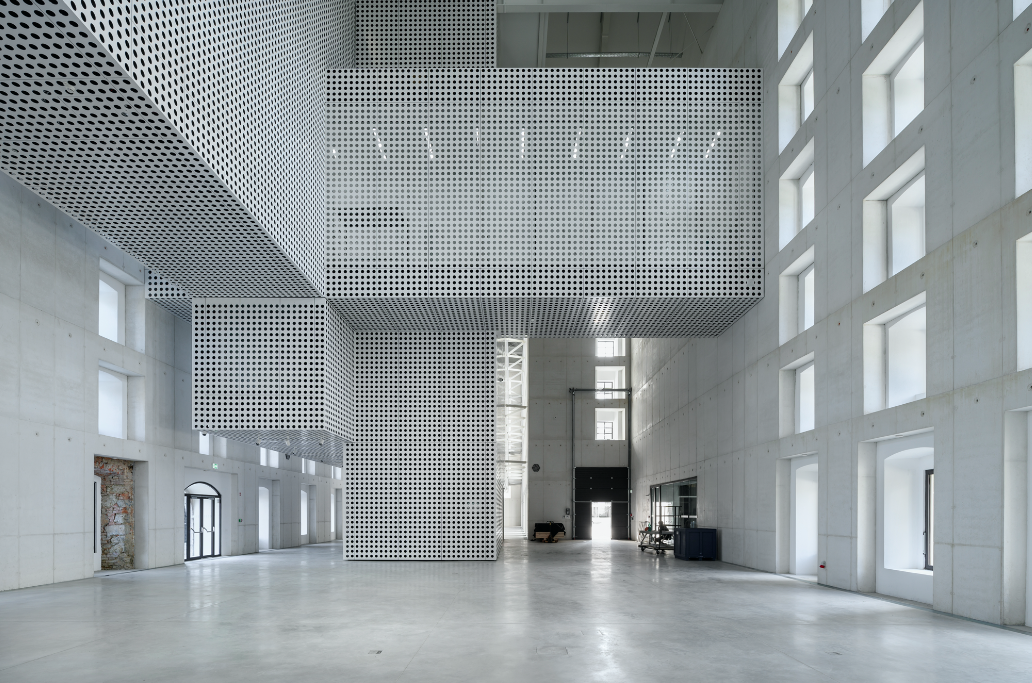
ph. Miran Kambič
The Wonderfulness of Memory / La Meraviglia della Memoria o l’inesauribile forza dell’arte
Il contesto dell’ubicazione dell’ex zuccherificio e la sua storia hanno offerto alla direttrice artistica e curatrice della mostra Alenka Gregorič una cornice concettuale per la mostra The Wonderfulness of Memory, che si concentra sull’intreccio tra passato e presente come tema centrale. Le opere in mostra guardano alla memoria come esperienza collettiva e individuale o come una questione di sentimento e razionalizzazione, dove la curatrice giustappone note, documenti scritti, archivi, narrazioni e oggetti trovati. Possiamo così intendere le opere come un omaggio a storie strappate all’oblio e allo stesso tempo intrecciate con le memorie scritte nel tessuto di Cukrarna come edificio.
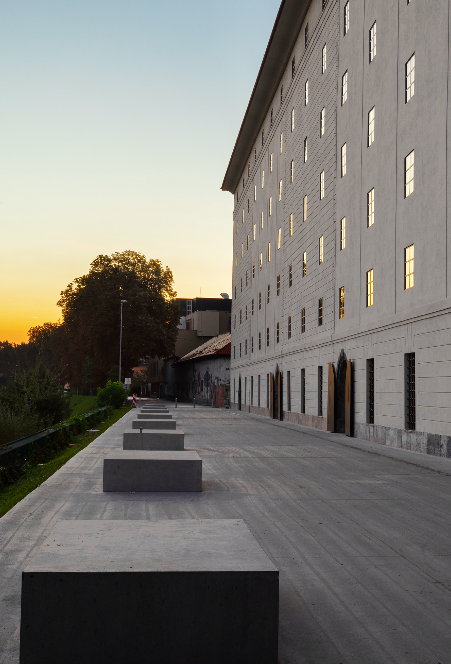
ph. Andrej Peunik
Alla luce delle storie in gran parte cupe su Cukrarna che hanno messo radici nella nostra memoria collettiva, la decisione della curatrice riguardo alla concezione della mostra è andata nella direzione di cambiare prospettiva e cercare modi per collegare il passato dell’edificio con la produzione artistica contemporanea, mentre indagando gli aspetti positivi e creativi del lavoro di un quartetto di modernisti che ha introdotto nuove idee, nuovi temi e nuove espressioni nello spazio culturale sloveno. Il titolo della mostra The Wonderfulness of Memory deriva da una riflessione contenuta in una lettera di Dragotin Kette a Ivan Cankar:
E ho anche riso della tua credulità, di come ami così tanto credere alla meraviglia che fuoriesce dalla bocca dei miei amici, una meraviglia che diventa meravigliosa solo grazie al loro meraviglioso ricordo.
La narrazione che emerge dalla lettura delle lettere che compongono la corrispondenza tra i due scrittori è quella di un passaggio dal passato al presente, poiché risulta – come spesso accade – che gli scrittori del movimento modernista sloveno erano afflitti da problemi simili a quelli che affrontano gli artisti di oggi: sono stati fraintesi e non rispettati, ma la loro fede nel potere dell’arte non è mai venuta meno e hanno perseverato fermamente nella loro missione.
Quindici artisti contemporanei presentano le loro opere alla mostra collettiva internazionale The Wonderfulness of Memory: Rosa Barba, Sophie Calle, Janet Cardiff, Jimmie Durham, Vadim Fishkin, Teresa Margolles, Ernesto Neto, Adrian Paci, Lia Perjovschi, Marjetica Potrè, Tobias Putrih, Miha Štrukelj, Aleksandra Vajd/Anetta Mona Chisa e Samson Young.
La necessità umana di preservare diversi tipi di registrazioni audio e video può essere identificata come uno dei fili narrativi del film 35mm di Rosa Barba From Source to Poem. Attraverso di essa ci incoraggia a pensare al valore del ricordare, alla necessità di conservare i registri per le generazioni future. L’esperienza personale e il ricordo doloroso di una perdita inaspettata sono i fili centrali di Exquisite Pain di Sophie Calle, sottile traduttrice di testimonianze personali nel linguaggio dell’arte, soprattutto attraverso il potere delle parole e della fotografia.
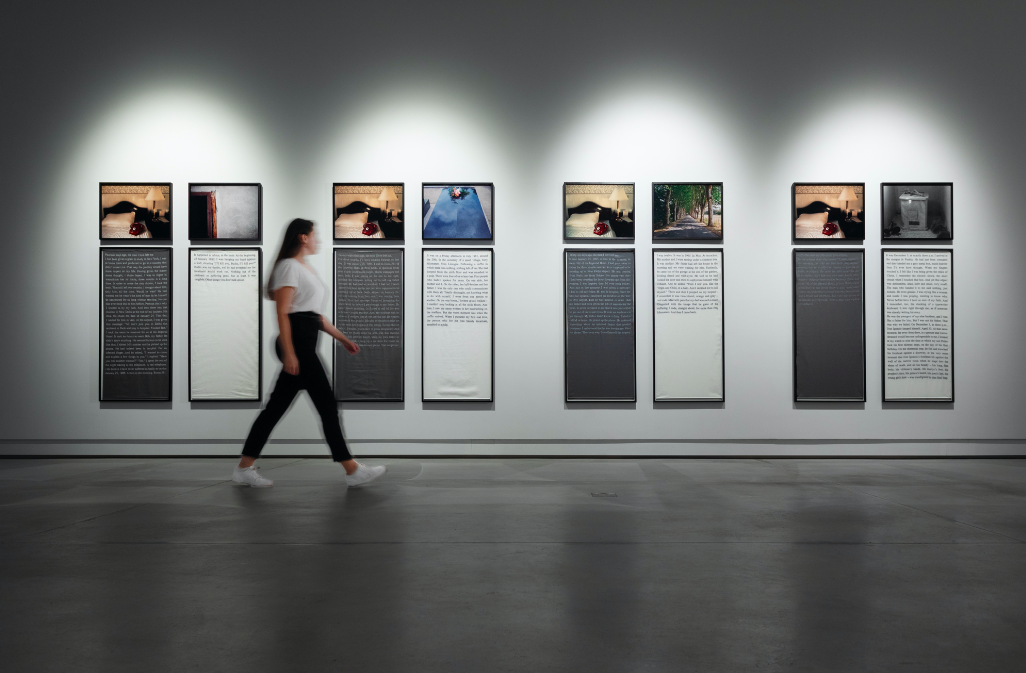
Sophie Calle, Exquisite pain, ph. Andrej Peunik
Il lavoro di Vadim Fishkin Dark Times ci ricorda, attraverso il ticchettio degli orologi, che ogni parte della nostra vita è solo uno dei suoni nella marcia verso la fine, solo uno dei suoni che inesorabilmente contano i minuti dal primo momento al infine, dal Big Bang al buco nero.
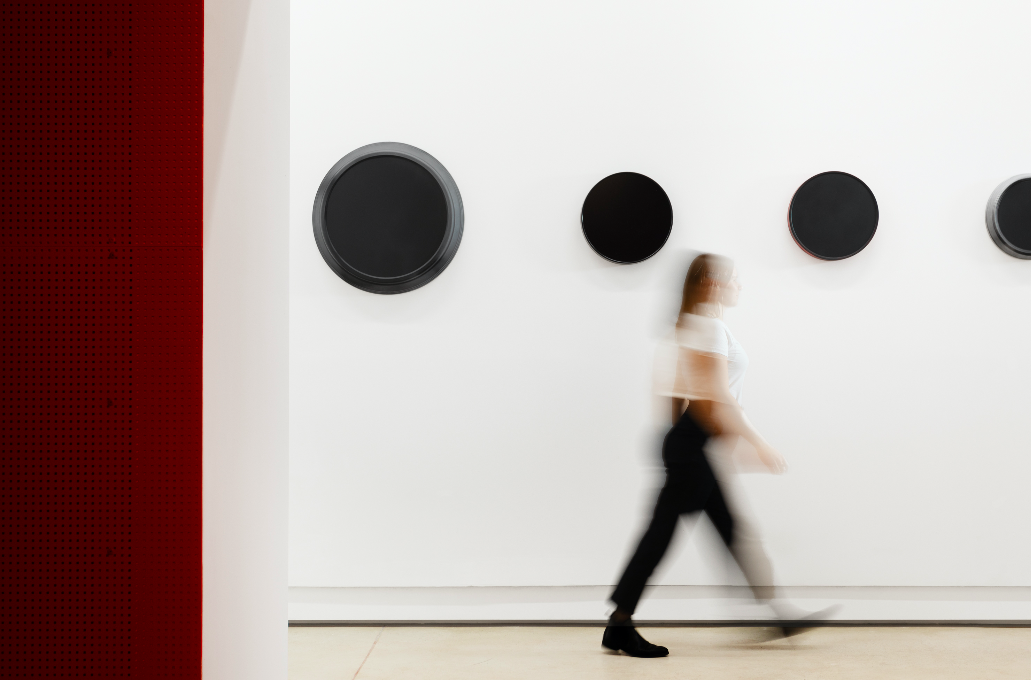
Vadim Fiškin, Dark Times, ph. Andrej Peunik
L’eterna evanescenza del momento è qualcosa che possiamo rintracciare nell’opera video Sonata for Smoke di Samson Young, che attira la nostra attenzione sugli strumenti solitamente invisibili con cui vengono creati video e film. La capitalizzazione del tempo – il suo uso ottimale e la minima perdita nella giornata lavorativa – è il tema de La Colonna di Adrian Paci.
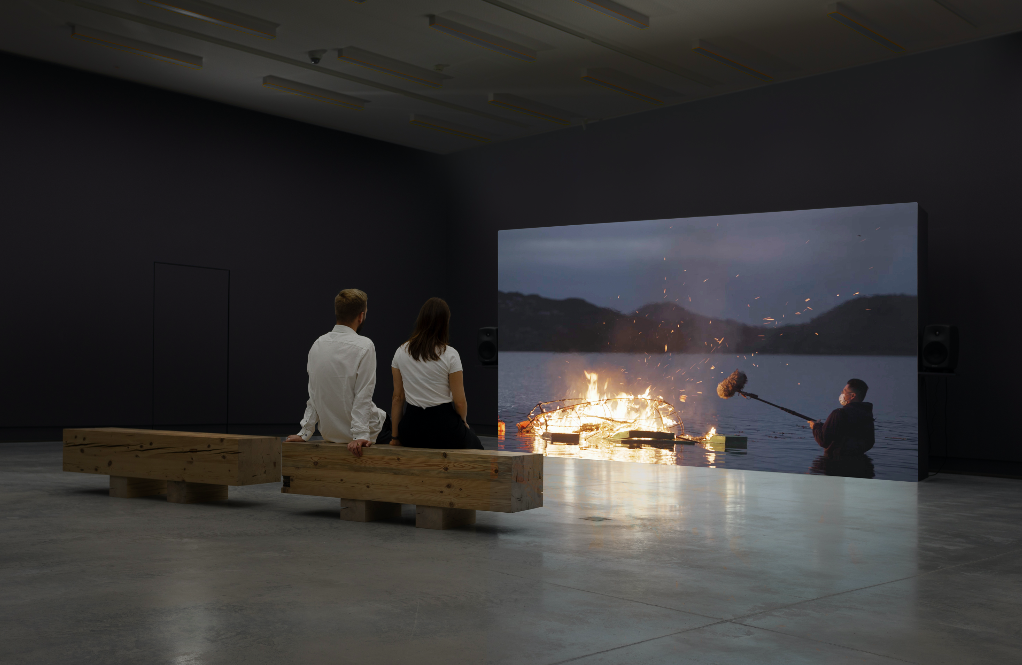
Samson Young, Sonata for Smoke, ph. Andrej Peunik
Con The Forty Part Motet, rielaborazione del mottetto Spem in alium del compositore inglese del XVI secolo Thomas Tallis, cantata dal Salisbury Cathedral Choir, l’artista Janet Cardiff indaga la memoria e il codice di accoglienza del pubblico.
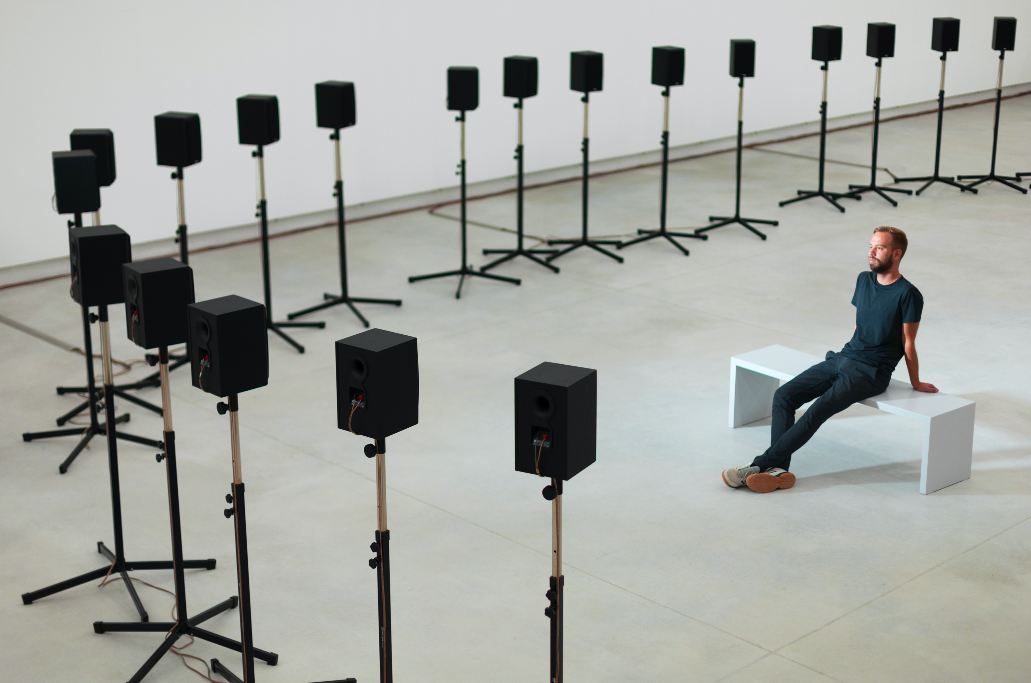
Janet Cardiff, The Forty Part Motet, ph. Andrej Peunik
Miha Štrukelj offre un resoconto della creazione dell’edificio in cemento che contiene le sue opere attraverso una serie di composizioni che a prima vista sembrano astratte, una delle quali è stata realizzata in situ, su un muro di cemento nel seminterrato di Cukrarna. Leggendo varia letteratura professionale e opere di narrativa, guardando film, ascoltando musica ed esaminando altri documenti di valore culturale del passato, Lia Perjovschi crea “sfere cosmiche” da cui emergono come raggi di sole idee e commenti, frasi e affermazioni, informazioni e fatti .
L’interpretazione di idee e soluzioni formali e architettoniche della storia recente è uno degli elementi chiave della pratica artistica di Tobias Putrih, che, dopo un’attenta analisi e interpretazione dei progetti del designer industriale italiano Enzo Mari, ha creato i propri progetti di mobili per la biblioteca Cukrarna, un progetto che chiama Walkingstick.
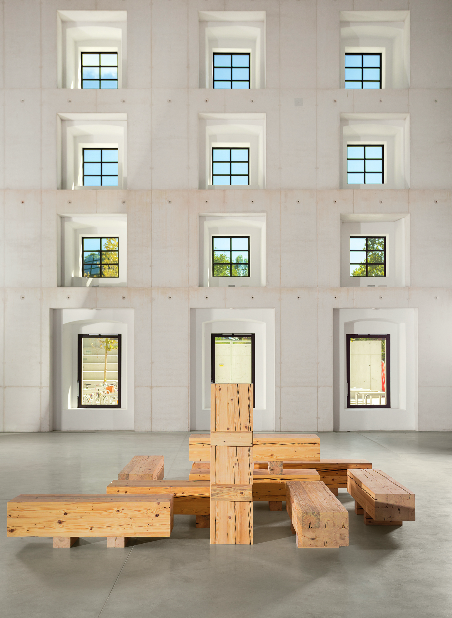
Tobias Putrih, Walkingstick, ph. Andrej Peunik
Gli interventi nello spazio di Aleksandra Vajd e Anetta Mona Chisa introducono alla sua drammaturgia un’ambivalenza dell’apparenza che richiama l’attenzione sulla possibilità di visioni e letture alternative.
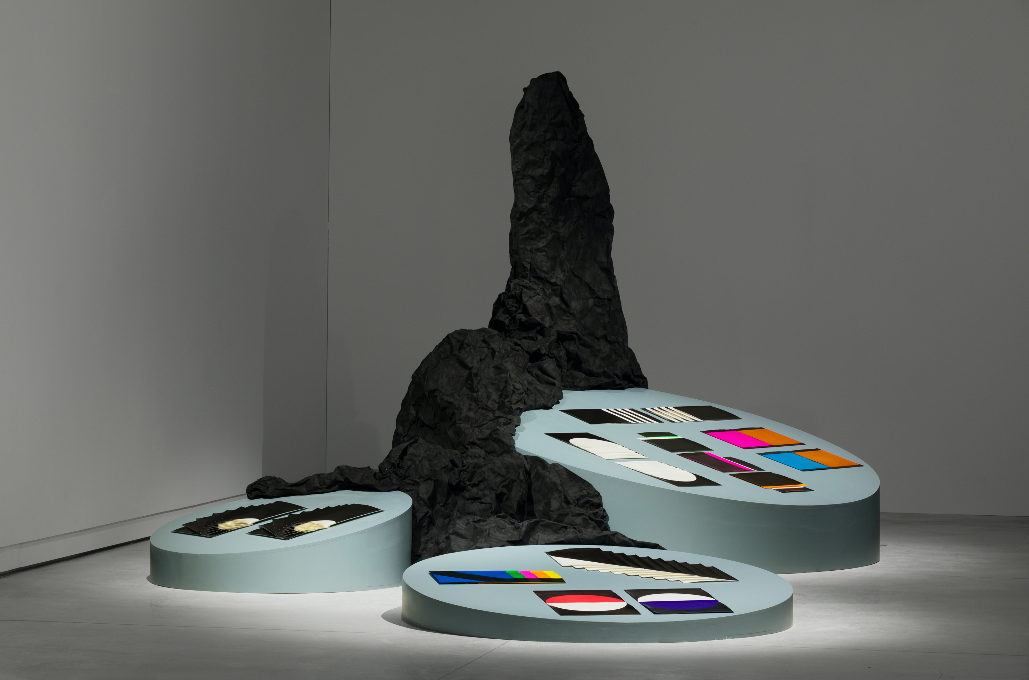
Aleksandra Vajd / Anetta Mona Chisa, Dramatic situation, ph. Andrej Peunik
In Recados Póstumos, Teresa Margolles colloca frammenti di appunti di suicidio sulle insegne dei cinema abbandonati come se fossero titoli di film. Jimmie Durham ci mostra, con i suoi assemblaggi Joe Hill Painting 1 e Joe Hill Painting 2, che la vita non è un ritiro dall’arte e l’arte non è un ritiro dalla vita. Le opere sono oggetti di scena del suo film La ricerca della felicità (2003) e, allo stesso tempo, testimoni della ricerca di armonia e convivenza compositiva tra materiali effimeri e di scarto. Marjetica Potrč è rappresentata alla mostra da The House of Social Agreement e dalle serie Earth Drawings e Drop City e Das Archipel.

Marjetica Potrč, The House of Social Agreement, ph. Andrej Peunik
Utilizzando gli strumenti dell’antropologia e della sociologia in combinazione con l’arte e l’architettura, l’artista rivela l’importanza della convivenza e la ricerca di modalità orientate alla sostenibilità per una gestione umana responsabile della natura. L’opera di Ernesto Neto Life is a River, creata per la prima Biennale Kochi-Muziris nel 2012, può essere vista come un riflesso del desiderio dell’artista di collegare la propria pratica creativa alla cultura indiana.
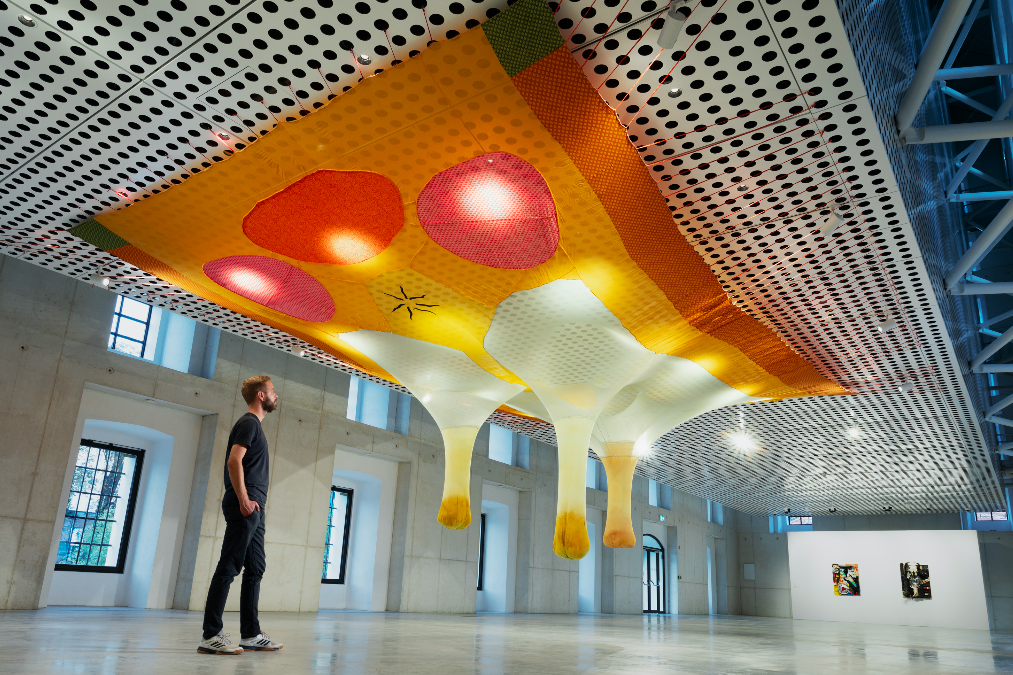
Ernesto Neto, Life is a River, ph. Andrej Peunik
Cukrarna a new space for contemporary art in Ljubljana, Slovenija
The newly renovated Cukrarna – a new space for the production and presentation of contemporary art – opened its doors to the public. One of the most monumental examples of industrial architecture in Ljubljana, a source of inspiration for a leading quartet of modernists, a modern exhibition space and also an urban landmark that invites us to stroll along the Ljubljanica to the eastern edge of the city centre Cukrarna is all these things. The City of Ljubljana, which has been guiding the extensive renovation of the building – to plans by architecture studio Scapelab – since 2018, has entrusted the management of Cukrarna to Museum and Galleries of Ljubljana. The inaugural exhibition, entitled The Wonderfulness of Memory, focuses on the interweaving of past and present as its central theme.

Marjetica Potrč, The House of Social Agreement, ph. Andrej Peunik
Scapelab’s architectural design
The project by Marko Studen, Boris Matić and Jernej Šipoš of architecture studio Scapelab was based on the history of Cukrarna, the planned new content and future orientation of the building, and the poor state of the existing structure.
Analysis of the state of materials before the start of the renovation showed that the walls were on the point of falling down. Together with the City of Ljubljana and the Institute for the Protection of Cultural Heritage, we saved Cukrarna at the last minute. Had we not done so, it would have suffered the same fate as the Kolizej complex in Ljubljana or the former Rakusch Mill in Celje.

ph. Andrej Peunik
The main entrance to the building is from the river side. The forecourt in front of the entrance connects the cycle and pedestrian path running along the Poljanski Nasip embankment. The ground floor is the only part of the building lit by natural daylight; the regulation of light, ventilation, temperature and humidity is envisaged for both gallery volumes. The two floating cubes are clad in perforated sheet metal, which serves an aesthetic purpose by giving a uniform appearance to the exteriors of the new spatial interventions while at the same time meeting functional requirements: concealed under it is acoustic insulation that absorbs echoes in the spacious gallery, along with elements of mechanical installations. The new basement contains a multipurpose auditorium, cloakrooms, visitors’ toilets, a heating plant and a workshop. On the ground floor there is a bar, which the architects have clad in black, in contrast to the gallery, while one of the walls reveals the original brick structure.
We are really satisfied with how the historical and the modern exist simultaneously in the new Cukrarna. They are defined by the gap between the internal volumes and the building envelope, a gap that is of the correct dimensions and the correct ratio. The visitor unconsciously gets the sense that something brand-new has found a space in something extremely old. Just as contemporary art will.
– Marko Studen, Boris Matić, Jernej Šipoš

ph. Miran Kambič
The Wonderfulness of Memory or the inexhaustible power of art
The context of the location of the former sugar refinery and its history offered Cukrarna’s artistic director and exhibition curator Alenka Gregorič a conceptual framework for the exhibition The Wonderfulness of Memory, which focuses on the interweaving of past and present as its central theme. The works in the exhibition look at the question of memory as a collective and individual experience or as a matter of feeling and rationalisation, where the curator juxtaposes notes, written records, archives, narratives and found objects. We can thus understand the works as a homage to stories that have been wrested from oblivion and are at the same time interwoven with the memories written into the fabric of Cukrarna as a building.

ph. Andrej Peunik
In view of the largely sombre stories about Cukrarna that have taken root in our collective memory, the curator’s decision regarding the conception of the exhibition has gone in the direction of shifting perspective and looking for ways to connect the building’s past with contemporary artistic production, while investigating the positive and creative aspects of the work of a quartet of modernists who introduced new ideas, new themes and new expressions to Slovenia’s cultural space. The exhibition title The Wonderfulness of Memory derives from a reflection contained in a letter from Dragotin Kette to Ivan Cankar:
And I also laughed at your credulity, how you so love to believe the wonderfulness that spill from the mouths of my friends, wonderfulness that only become wonderful because of their wonderful memory.
The narrative that emerges from a reading of the letters that make up the correspondence between the two writers is one of a transition from past to present, since it turns out – as is so often the case – that the writers of the Slovene modernist movement were plagued by similar problems to those facing artists today: they were misunderstood and disrespected – yet their faith in the power of art never waned and they persevered steadfastly in their mission.
Fifteen contemporary artists present their works at the international group exhibition The Wonderfulness of Memory: Rosa Barba, Sophie Calle, Janet Cardiff, Jimmie Durham, Vadim Fishkin, Teresa Margolles, Ernesto Neto, Adrian Paci, Lia Perjovschi, Marjetica Potrč, Tobias Putrih, Miha Štrukelj, Aleksandra Vajd/Anetta Mona Chisa and Samson Young.
The human need to preserve different types of audio and visual recordings can be identified as one of the narrative threads of Rosa Barba’s 35mm film From Source to Poem. Through it she encourages us to think about the value of remembering, about the need to keep records for future generations. Personal experience and the painful memory of unexpected loss are the central threads of Exquisite Pain by Sophie Calle, a subtle translator of personal testimonies into the language of art, above all through the power of words and photography.

Sophie Calle, Exquisite pain, ph. Andrej Peunik
Vadim Fishkin’s work Dark Times reminds us, through the ticking of clocks, that every part of our life is just one of the sounds in the march to the end, just one of the sounds that inexorably count down the minutes from the first moment to the last, from Big Bang to black hole.

Vadim Fiškin, Dark Times, ph. Andrej Peunik
The eternal evanescence of the moment is something we can trace in the video work Sonata for Smoke by Samson Young, which draws our attention to the usually invisible instruments with which video and film are created. The capitalisation of time – its optimal use and minimal loss in the working day – is the theme of The Column by Adrian Paci.

Samson Young, Sonata for Smoke, ph. Andrej Peunik
With The Forty Part Motet, a reworking of the motet Spem in alium by the sixteenth-century English composer Thomas Tallis, as sung by Salisbury Cathedral Choir, artist Janet Cardiff investigates memory and the reception code of the audience.

Janet Cardiff, The Forty Part Motet, ph. Andrej Peunik
Miha Štrukelj offers an account of the creation of the concrete building that contains his works through a series of compositions that at first glance seem abstract, one of which he has created in situ, on a concrete wall in the Cukrarna basement. By reading miscellaneous professional literature and works of fiction, watching films, listening to music and examining other documents of cultural value from the past, Lia Perjovschi creates “cosmic spheres” from which ideas and comments, sentences and statements, information and facts emerge like sunbeams.
The interpretation of ideas and formal and architectural solutions from recent history is one of the key elements of the artistic practice of Tobias Putrih, who, after careful analysis and interpretation of designs by the Italian industrial designer Enzo Mari, created his own designs for furniture for the Cukrarna library, a project he calls Walkingstick.

Tobias Putrih, Walkingstick, ph. Andrej Peunik
Aleksandra Vajd and Anetta Mona Chisa’s interventions in the space introduce an ambivalence of appearance to its dramaturgy that draws attention to the possibility of alternative views and readings.

Aleksandra Vajd / Anetta Mona Chisa, Dramatic situation, ph. Andrej Peunik
In Recados Póstumos, Teresa Margolles places fragments of suicide notes on the marquees of abandoned cinemas as though they were movie titles. Jimmie Durham shows us, with his assemblages Joe Hill Painting 1 and Joe Hill Painting 2, that life is not a retreat from art and art is not a retreat from life. The works are props from his film The Pursuit of Happiness (2003) and, at the same time, witnesses to the search for harmony and compositional coexistence among ephemeral and discarded materials. Marjetica Potrč is represented at the exhibition by The House of Social Agreement and the series Earth Drawings and Drop City and Das Archipel.

Marjetica Potrč, The House of Social Agreement, ph. Andrej Peunik
Using the tools of anthropology and sociology in conjunction with art and architecture, the artist reveals the importance of coexistence and the search for sustainably oriented modes of responsible human management of nature. Ernesto Neto’s work Life is a River, created for the first Kochi-Muziris Biennale in 2012, can be seen as a reflection of the artist’s desire to link his own creative practice to Indian culture.

Ernesto Neto, Life is a River, ph. Andrej Peunik

